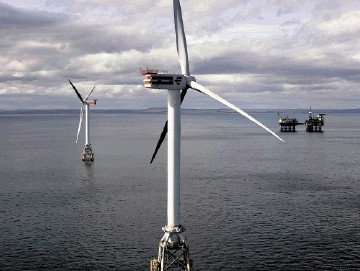
A major offshore wind farm which would have been visible from a World Heritage Site coastline has been turned down.
Developers had applied to build a wind farm with up to 194 turbines more than eight miles off the coast of Dorset and the Isle of Wight which could have been seen from large stretches of the Jurassic Coast and areas of outstanding natural beauty (AONBs).
The UK Government has refused planning permission for the controversial Navitus Bay wind farm – which had prompted debate in Parliament – amid fears over the “possibility of significant adverse impacts on the use and enjoyment of the World Heritage Site”.
It also turned down an alternative proposal for a wind farm which would have comprised of up to 105 turbines, in line with the recommendations by the planning inspectorate.
As well as having impacts on the World Heritage Site, the wind farm would have affected protected monuments, involved onshore development in the New Forest National Park and could have hit tourism in some areas, the inspectorate concluded.
The Government said it had considered all the energy and planning issues involved in careful consideration of the application, but had concluded the adverse impacts of the scheme outweighed its benefits.
The move was welcomed by Purbeck District Council which had objected to the scheme because of its effects on the AONB landscape, the Jurassic Coast, Durlston Castle and Park and local tourism.
Council leader Gary Suttle said: “Although the council fully supports sustainable energy, the potential adverse impacts of such a large scale development outweighed any potential benefits.”
But supporters of green energy criticised the decision.
Industry body RenewableUK’s chief executive, Maria McCaffery, said: “It’s deeply disappointing that Navitus Bay has been refused consent.
“This is a missed opportunity as it means we’re failing to capitalise on the UK’s superb offshore wind resource and the economic benefits it brings.
“Years of hard work and significant investment went into developing this project which could have added £1.6 billion to the economy of the region and created up to 1,700 jobs – it’s most unfortunate that that has now been lost.”
Greenpeace chief scientist Dr Doug Parr said the decision, along with moves to cut solar and onshore wind subsidies ran in completely the wrong direction in combating climate change.
He added: “Whilst government is happy to reject a nearby offshore wind on the grounds of aesthetics, it puts up a vast swathe of land on the Isle of Wight which include Areas of Outstanding Natural Beauty as a major potential fracking site.
“Just like the rest of their energy policy this decision reeks of incoherence at the heart of government thinking.”
The National Trust said it was committed to renewable energy but had opposed the wind farm as “the wrong proposal” for the location.
Ian Wilson, assistant director of operations for the National Trust in the South West, said: “Our objection was because of the impact on the beautiful coastlines of East Dorset and the Isle of Wight, including well-loved sites such as the Needles on the Isle of Wight, and Old Harry Rocks on Purbeck.”
He added: “We believe strongly in the need to grow renewable energy generation and wean ourselves off fossil fuels, but it has to be in the right place at the right scale.
“We could not support the location and scale of the original plan put forward by Navitus Bay Development Ltd so close to National Trust land and the World Heritage Site,” adding the trust also had concerns about the process for the development.
Recommended for you
